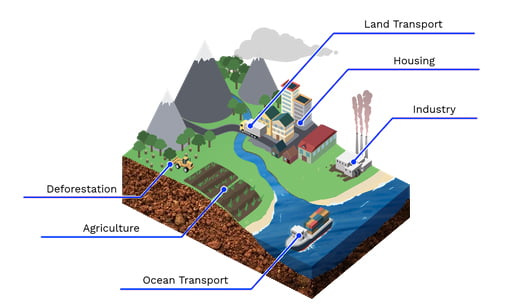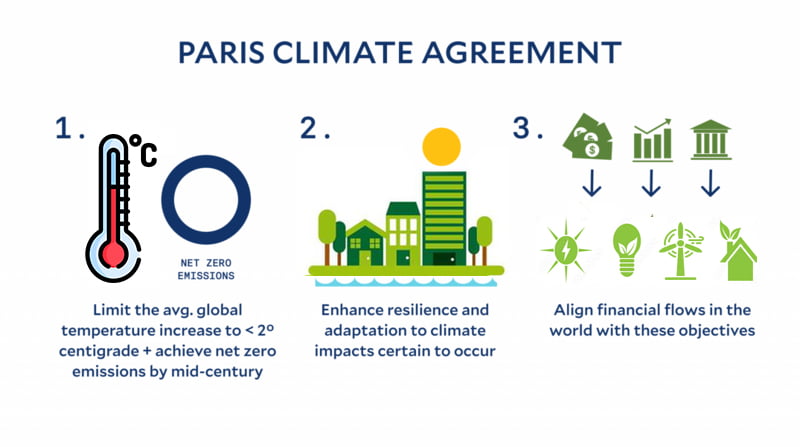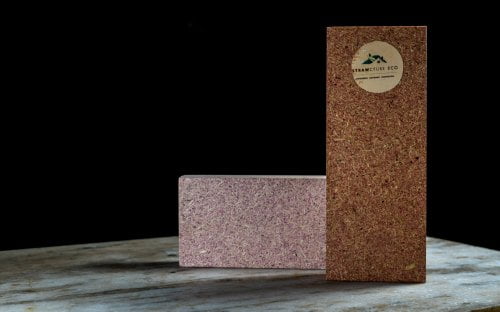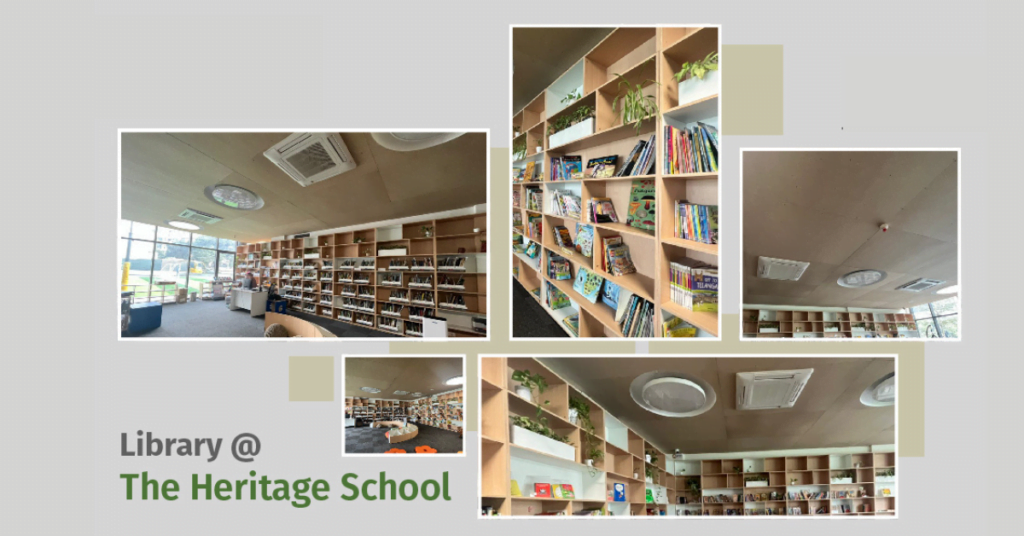The world has had our 6th warmest year on record. All the heat over our faces while walking along a street of buildings and cars is a reality! 2022 was the 6th warmest year since global records began in 1880 (based on NOAA’s temperature data). Going a bit away, the 10 warmest years in history have all occurred since 2010. ‘Hotter-than-average’ temperatures have been recorded across most of the globe in 2022. Looking into the case of Asia and Europe, 2022 saw the second warmest temperature, with 2020 still being the highest.
The air, oceans, and surfaces have all warmed up, snow and ice are vanishing at an alarming pace, and the sea level has threateningly risen. Furthermore, the concentrations of greenhouse gases have increased, especially CO2 emissions and ozone-depleting halocarbons.

Anthropogenic climate change remains one of the most petrifying challenges to be faced and mitigated by the human race. Human influence drives a lot of the above-stated figures. The increasing greenhouse gas concentrations result from urbanization and human-induced land use.
Where is the Construction Industry going?
The Global Status Report for Buildings and Construction, 2019, shows that almost 40 per cent of energy-related greenhouse gas emissions are from the building and construction sector. Due to their high ’embodied energy content’, sustainable building materials such as Concrete, Brick, Steel and Aluminium are significantly responsible for extensive CO2 emissions.

“As we keep changing the surface of land through remorseless construction activities, there is no realm of the environment that remains untouched from the detrimental impact of the sector.”
From the raw materials extraction to the operation of the built form, the entire life cycle of a Construction project, from the cradle to the grave, has consequences that linger long after the process has stopped. Worryingly enough, the industry is an extensive natural resource consumer (read exhauster!) responsible for emissions and pollutants. Scaling down the built environment’s carbon footprint is a mammoth task.
“Lack of real transformation from the sector means that the emissions will keep rising and contribute to dangerous climate change” -UN.

In alliance with the Paris Agreement that aims to limit the temperature rise to 1.5C, the world is adopting long-term strategies and ambitious actions towards a net-zero emission World. Implementation of the Paris Agreement requires a concoction of economic, social and scientific strategies. Macro to micro institutions, collectives and companies are establishing ‘Carbon Neutral’ or ‘Zero-Carbon’ Solutions for accelerated growth. The decarbonization of the built environment has to be along its entire lifecycle.
Impending decision-making shifts and Effective Policy Intervention is vital to reduce and eventually reverse the impacts. Revisiting our choices will decide the course of future Architecture.
The further progression of the construction industry needs to be driven by innovation, climate sensitivity and sustainability. Attention to Material Efficiency in the building sector can potentially reduce pressure on the consumption of natural resources and ’embodied carbon.’ Limiting climate change will require sustained efforts that start from the fundamentals and create a substantial impact.
“The future of Architecture in India and the world will be dominantly dependent on how we design, choose, and particularly, build.”

The age-old formula of Reduce and Recycle
Designs with fewer or alternate materials using recycled construction materials are a few of the most promising strategies, per the UN’s Environment Program (UNEP). Innovative approaches and use could significantly reduce emissions from the material cycle of residential buildings alone.
It’s time for policymakers, planners, architects and designers to prioritize using recycled and eco-friendly building materials. Additionally, attention has to be given to the input energy and resources that run a building’s mechanism.
One man’s trash can be another man’s treasure. Likewise, for the building sector – Optimized resource utilization, waste reduction is an approach that syncs well with nature. Composite materials produced from Agricultural residue that have multiple applications in the building industry are the kind of innovations that will make the world truly “Green”.

Agribiopanels, by STRAWCTURE ECO, are compressed Agri-fiber green panels made of straw bales, which offer a completely sustainable, green building solution for the next generation. They follow a circular economy by reusing natural resources such as farm waste in manufacturing construction materials. Its multi-faceted application makes the Agri-fiber panels durable and resilient to extreme conditions.

Choosing the right materials for Health and Well-being
With a majority of one’s life being spent indoors, inspecting and evaluating what goes into the making of the built environment is essential. The surroundings have a direct impact on human well-being. Unsustainable processes in manufacturing the majority of the traditionally used building materials have a toxic effect on indoor air quality, thereby on human health and productivity.
“The increased Consciousness for a healthy and sustainable life has its roots deep down in a renewed understanding of the materiality of our built forms.”
Right from inception to completion, mindful use of building materials and green techniques can ease the carbon footprint from the construction, operations, and demolishing stages of the building. The market needs to promote more materials that depend less on natural resources, act as catalysts in the faster construction process, are low on structural load and follow a clean manufacturing cycle.
While increasingly new construction is taking cognizance of this trend, schools and hospitals seem to be the earlier adopters. Heritage International School adopting sustainable architecture, chose Strawcture Eco Agribiopanels with its 2-hour plus fire resistance and CO2 sequestering capability for its Auditorium and Library to ensure healthier air quality for the students.


Going local is the Saviour!
Sometimes to fit in is more sensible than to stand out. True to the context, employing materials and methods that are socially, economically, and environmentally friendly is wise.
The key to resilient planning and architecture lies in the modesty of locally available resources. Locally conscious choices, with deliberate efforts to calculate the impact of our choices, go a long way in achieving sustainable goals.

Reuse & Retrofitting is the new “NEW.”
What works for a longer duration – is sustainable. The greed to build new is irreversibly saturating our environment beyond our knowledge and needs to pace down. Design drivers in today’s world need to change to long-lasting and timelessness—demolition results in large amounts of waste resulting in pollution of all kinds. Rebuilding means consuming more resources, making the cycle energy-intensive, and emitting a staggering amount of CO2.
Refurbishing longstanding poor-performing buildings to be more energy efficient and self-sufficient should be the new-age mantra for longevity.”
Dr. Julie Godefroy, an Engineer from The Chartered Institution of Building Services, observed, “We have to avoid demolition and new-build. Often most of the material in an existing building is underground – so we should seek to use existing foundation.”

The mindless knocking down of buildings reflects the ‘throwaway’ culture that needs to be rethought radically. It is becoming more crucial to maximize the life and use of every inch of existing infrastructure to its optimum capacity to fulfil the climate commitment.
One good example is the recent Catherine Commons Deconstruction Project—a collaborative effort of the Circular Construction Lab with the non-profit organization Finger Lakes Reuse and the architecture firm Trade Design Build—that put the concept into real-world practice.
The project was the development of 300 brand-new housing units just south of the Cornell campus, which required the demolition of 11 early 20th-century residential structures. A team from the Seattle-based Deconstruction Institute convinced the developer to salvage non-structural elements from ten buildings while completely deconstructing the last. The same was painstakingly done over 7 days, and all materials salvaged were reused. Based on the lab’s calculations, the deconstructed house represented more than 13 tons of carbon diverted from landfills.
Going Green is about changing our thinking and how we look at construction. It is time to sift the bias from the truth. It is time to embrace change.




